Chapter 4
Expectations and Credibility
For Retail HVAC In-Home Comfort Advisors
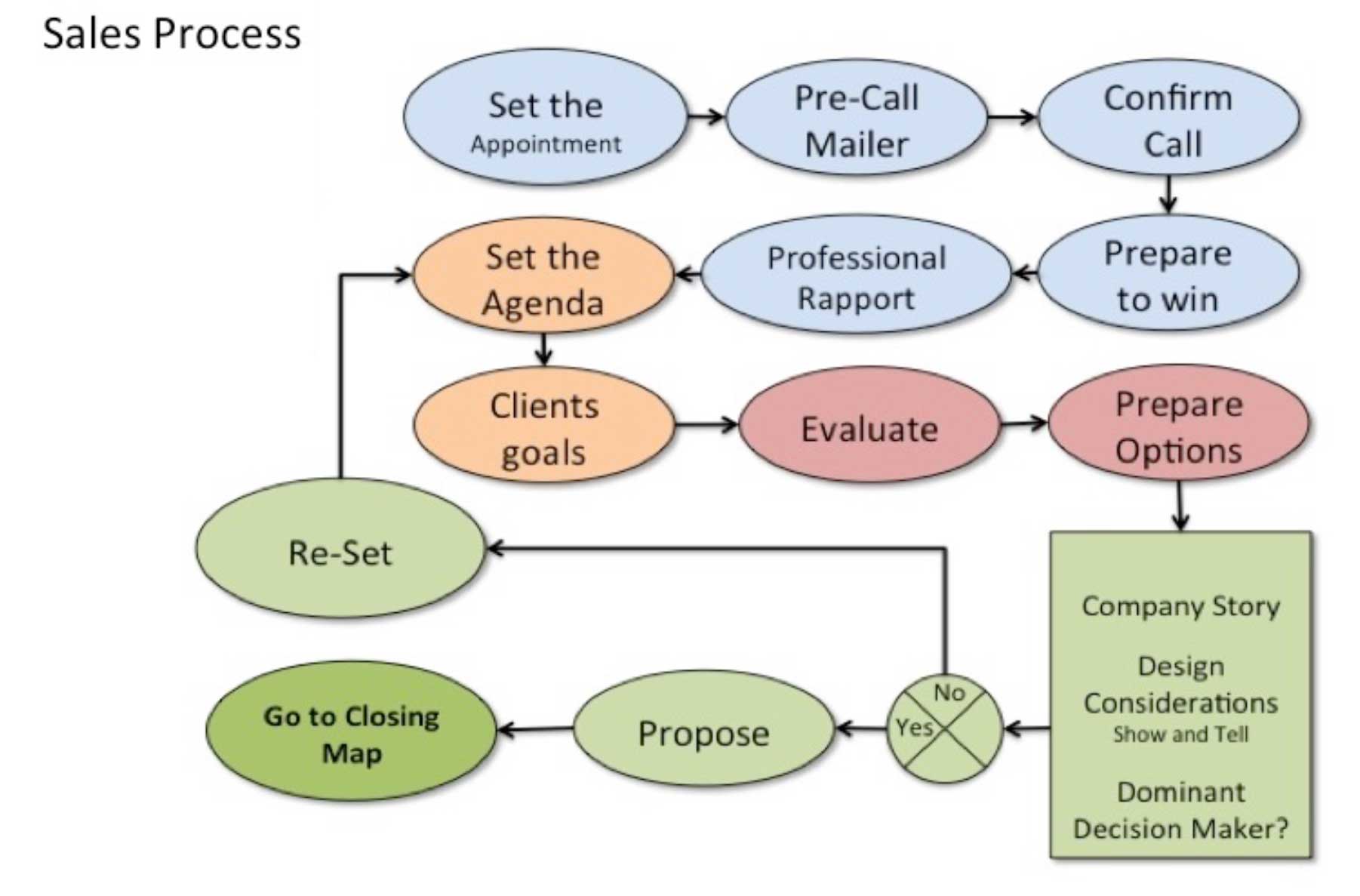
By: Tom Wittman
HVAC Business Coach-Consultant-Speaker
(317) 750-1607
CoachTomw@Gmail.com
HVAC Coaching Corner
www.HVACCoachingCorner.com
Pro Comfort Advisor LLC
www.ProComHVAC.com
The Replacement sales process…
An organized sales visit is important so you know where you are in the process and you know the purpose of every single step. You must look at it from the homeowner’s point of view. You are taking them on a journey from I’m sort of interested in what this person has to say to this person has the best solution and I’m very confident that if I write them a check I will be in a better place.
The natural outcome of a well-orchestrated sales process is the sale. The replacement sales process is designed to quickly connect with each customer and give him or her every reason they should buy from you. However, as you
probably know, when you ask for the order, you’re almost always going to have objections.
A professional salesperson expects them and has a plan to handle each and every one of them successfully. That’s what the Replacement closing map does. It helps you discover the reasons for not buying and equips you to solve the problem.
Chapter 2 Step 3 Expectations and Credibility
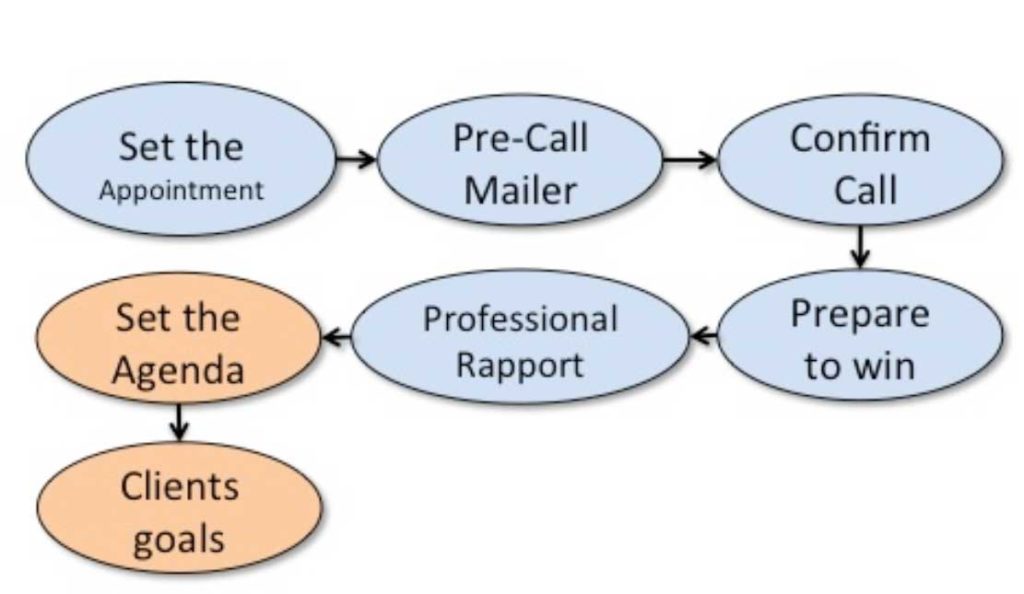
The objective of Expectations and credibility is simply to set the agenda for your visit and create a list of goals with your customer to make sure that you are clear on everything your customer wants.
When you are clear on what your customer wants and your customer is clear on what you will be putting together for them, you create interest from your customer to learn more about how you plan to accomplish everything on their list of goals. This “anticipation” influences a desire to learn more.

Time Commitment
“This will take about 60 to 90 minutes, are we ok on time?”
Establish a place to work
“Would there be a kitchen table or counter I can use as a workspace to put together our results and recommendations?”
Explain today’s agenda
(As you and the customer are walking to the place to work) “I’ll need access to the attic, Crawlspace or Basement and other areas of your home, is there any area of the home you prefer I not go into?”
“It will take me about 20 minutes or so to look everything over and then, I’ll need about 10 to 15 minutes to put everything together for us to review.”
Transition into establishing “Client Goals”
“To make sure I don’t miss anything that might be important to you, I need to ask a
few more questions, Ok?”
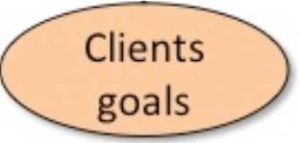
Homeowners who feel like you don’t understand their situation or concerns won’t trust your recommendations and will simply not buy from you. The best way to really know their concerns and show them that you understand is to ask a lot of questions.
You also have to be observant and watch the customer’s body language during your visit. Often times the customer may tell you one thing while their body language communicates something completely different so you must focus on your customer and listen to what their body language is communicating to you.
The types of questions you ask are very important as well. If you ask closed-ended “Yes, No” questions like “Do you have any rooms that are hot in the summer or cold in the winter” The customer will naturally respond without giving your question any thought. A series of questions like this conditions your customer not to listen and simply say “No”.
Rephrase the question. Assume there may be a problem and ask like this: “Which areas of your home are difficult to heat or cool?” That’s an assumptive, open-ended question. Your customer has to process the question, give the answer some thought and reply with a thoughtful response. Don’t forget to watch your customer’s body language, they might be telling you one thing while their body language is communicating something different. Pay attention.
When your customer reveals that they are having an issue, don’t just “check a box” and move on. STOP! Acknowledge the issue and ask them to tell you more about that. Ask how long have they been dealing with this issue. Get your customers talking about the problem. Then, turn their issue into something you can deliver.
Example:
If they say: “The upstairs bedroom is hot in the summer”
You say: “So, you want the bedroom to be more comfortable?
Customer: “Yes”
You Say: “Ok, let me write that down. Make the upstairs bedroom comfortable in the summer, Right?” Congratulations! You’ve established a goal!
You are taking your customer on a journey from I’m sort of interested in you have to say, to I’m very confident that if I write you a check I will be in a better place. This is the beginning of that journey.
The following page is an example of a customer questionnaire:
Take a moment and review the questions.
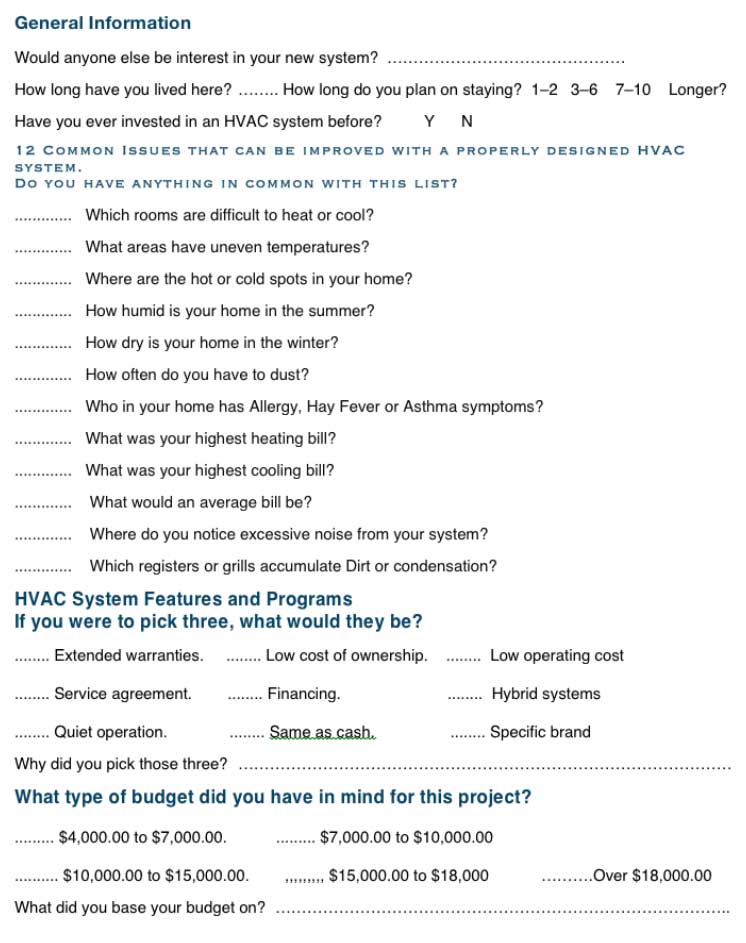
General Information
Would anyone else be interested in your new system? ………………………………
When your customer answers this question with a yes, ask for their name, write it down and remember it. We will be involving them in the process later. Then ask: “Will they be joining us?
Move onto the next question, regardless of the answer.
How long have you lived here?…….. How long do you plan on staying? 1–2 3–6 7–10 Longer?
If your customer purchased the home recently, they might not have had enough time to experience any comfort or health issues. You will have to dig deeper during the operational assessment, discover things that may compromise comfort, health or safety and bring those things to your customer’s attention during the Review Options steps.
If the homeowner has lived in the home for more than a year, they should have enough time with their home to have experienced any health or comfort issues.
The answer to how long they plan on staying in the home will give you an indication of their interest in a short term equity return on their investment or a longer-term return on investment. This in no way should ever prompt you to disqualify them from reviewing all options. Best, Better, Good and Base. Do not pre-qualify your customers. We will review how to let them qualify themself later in the process.
Have you ever invested in an HVAC system before? “Y” “N”
If they answer yes to this question, they may have established a budget based upon the system they bought before. Follow up by asking: How long ago was that?
Wait for their response….
“There have been a lot of advancements with HVAC systems since then, after we determine what size of system your home needs, you and I can review all of the different options until your comfortable with your system and the price, ok?”
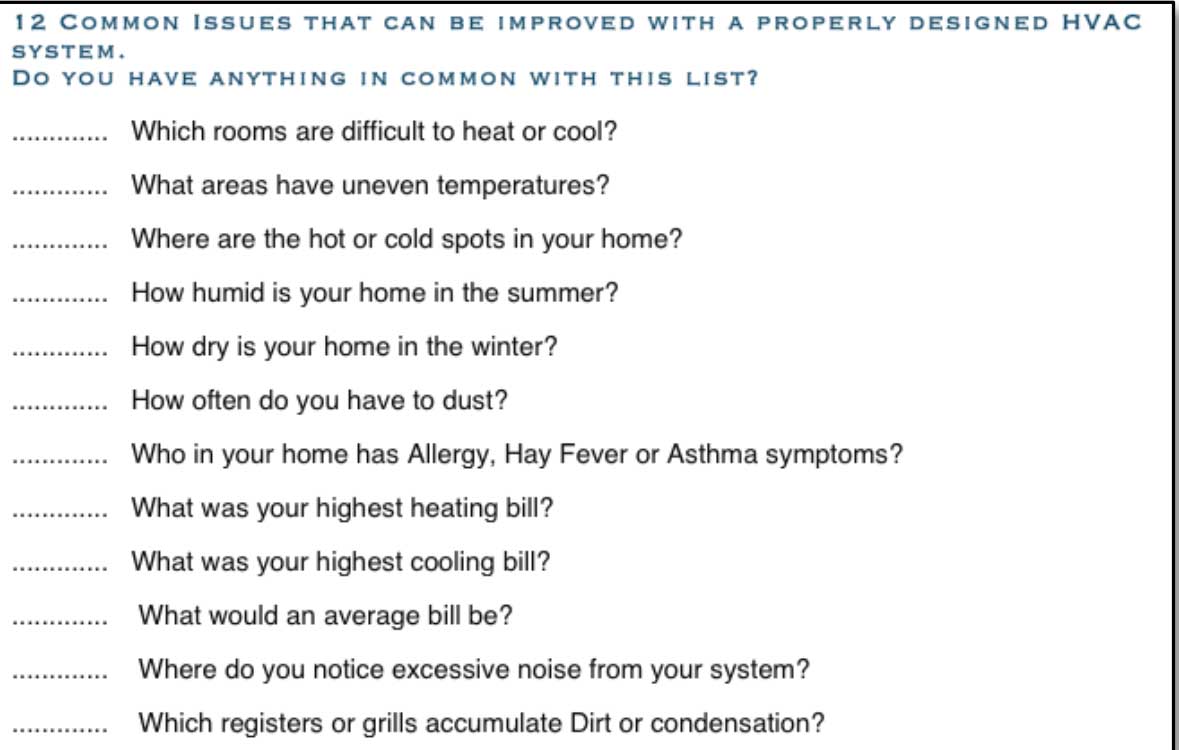
The 12 common issues questions help you and your customer establish a list of goals. Use common sense. If your customer had already shared some of the things on this list with you earlier, skip those questions, re-visit the issues they shared with you earlier and then ask the remaining relevant questions.
You should be prepared with a pad-folio: The left side of the pad-folio would be the questionnaire and the right side would be a yellow note pad where you can neatly write down your customer’s list of goals.
(Make sure to let your customer see what you are writing).



When they tell you that they are having a problem, get them talking about it by using follow up questions and people skills:
“Tell me more about that.”
“How long have you been dealing with this?”
Then, convert their issue into something that you can do.
For example:
“What I’m hearing you say is that you want us to…”
“Make the living room easier to heat and cool.” (Write it down)
“Even out the hot and cold spots.” (Write it down)
“Make the master bedroom warmer in the winter.” (Write it down)
Write it down and repeat it to your customer to make sure that you get it right and make sure your customer is able to see what you are writing down. (Don’t hide it).

Customer: “Yes, it does get humid in the summer and dry in the winter”
Tell me more about that…
How bad does it get…
“If I’m hearing you correctly, you would like to have better humidity control, right?
“Ok, Maintain better humidity control in your home. Right?” (Write it down)

Customer: “It seems like I’m always dusting”
“If we could reduce the amount of dust in the home, would that be important to you?
“Ok, Reduce the circulation of dust in the home, right?” (Write it down)

Customer: “My Daughter Andrea”
“How severe are the symptoms?”
“Is it seasonal or consistent?”
Would reducing allergy triggers be an important option for you?
Ok, “Reduce allergy triggers, right?” (Write it down)

“Wow, have your bills always been this high?”
“Would lowering your heating and air conditioning operating cost be important ?”
“Ok, Lower air conditioning and heating bills, right?” (Write it down)

Yes, it gets quite noisy outside when we are sitting on the patio”
“Sounds like we should look into making the outside unit quieter, so you can enjoy the patio?”
“Ok, reduce the noise from the outside unit, right?” (Write it down)
By now, you should have established three of four things your customer wants their system to do for them beyond simply heating or cooling their home.
Now, all you have to do is determine how to do it and show and tell them everything they need to see and hear to believe that you can solve everything on their list of goals.

Next, hand your customer a pen, slide the worksheet toward them and ask them to choose three of the nine additional features they want with their new system.
After they choose, ask “Why did you choose these three over the other six?”
This conversation will give you valuable insight as to why these three benefits are important to them compared to the other six. They are telling you what’s important to them! When you put their options together, make sure to include everything they told you they wanted with their new system.

The answer to this question will give you valuable insight into how much research they have already completed. Did they speak to other HVAC salespeople? Did their neighbors talk to them about their experience when they bought their new system? Did they search the Internet to obtain budgets? Maybe, they had no idea what a new system would cost in the first place. What are they basing their budget on or did they have any budget in mind at all?
Caution: do not pre-qualify the customer just because they gave you an answer to this question. Customers oftentimes make the decision to spend more money on things they really want. Customers usually buy the things that are brought to their attention and are willing to pay more than they originally thought they would.
For Example:
- Better humidity control
- Dust reduction
- Noise reduction
- Reducing operating costs
- Making areas of the home more comfortable
- Reducing Allergy triggers….
You do however need to be prepared to explain what makes up the price.
Keeping your customers in control of buying.
You are in control of the process. Your customer has to maintain control of buying. When your customers feel like they have no control over a situation, their response may be emotionally charged because of fear; fear of making a mistake or fear of not having a choice. Your mission is to keep your customer in control. At this point, if the customer responds emotionally to your question regarding their budget, they’re really saying that they feel like they have no control over the price and are afraid of making a mistake. Your job is to put the customer squarely in control of the buying process.
Explain what makes up the price:
“The price depends on three things. The proper size of the system for your home, the type of system you want and how much additional work makes sense for you.”
Put them in control:
“I’m not here to sell you anything. But I will let you buy it from me if it makes sense. But before you buy it from me, it has to make sense for you first, right?” You have complete control over the price based upon the type of system you choose and how much of the additional work makes sense for you.
Re-set the agenda.
How about we quickly review your goals to make sure I’m clear on what you want. Then I’ll assess your system, the condition of the installation and put together a few options. Then, I’ll show you what I found, explain how we propose to address everything on your list of goals and decide what type of system makes sense for you and how much of the work additional work you want to do now, Ok?”
Review the Goals:
“If I heard you correctly, you want to:
Make the upstairs bedroom more comfortable in the winter
Reduce allergy triggers in the home
Minimize the amount of dust
Reduce the electric and gas bill
Is that correct?”
“Would you mind numbering these for me in order of priority?”
“Is there anything not on this list that (the person from question 1) John, your husband would want?”
“If I find anything else that has to do with health or safety issues, may I bring it to your attention?”
“Ok, Time to get to work. You are welcome to come along if you like, or we can break apart for 20 minutes or so and I’ll find you when I finish. I would appreciate it if you could show me where the thermostat, indoor unit, attic access, and outdoor unit is, thank you.”
NOTE: If your customer decides not to “follow along”, be prepared with some letters of recommendation, testimonials, before and after photographs, Industry news and or product information organized in a professional-looking binder for them to “review” while you are completing your assessment.

